Scandinavian Christmas
Whether you’re looking to adopt new traditions or learn the history of practices your family has done for generations, we’ll explore some of the common Scandinavian Christmas Traditions and where they come from.
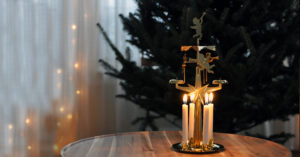
Advent
Advent typically represents the four Sundays preceding Christmas in the Christian faith. In every form, it’s a countdown to Christmas and begins a season of preparation and anticipation of holiday celebrations. Advent comes from the Latin word for “coming,” adventum, and there are countless ways to participate! Much of advent revolves around light, representing the light that Christ brought into the world with his birth. Having extra light and warmth in the cold beginnings of winter is also an inspiration for people to have advent lights or candles. Even a Christmas tree, a tradition that began before Christianity, provides this comforting light and in many homes, picking a Christmas tree is the beginning of the season.
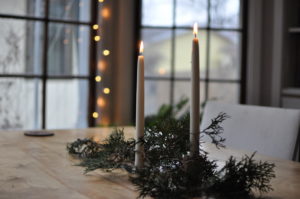
Across cultures, winter solstice inspired celebrations that have since combined with Christianity’s Christmas. Yule (modern Jul in Scandinavia) is said to have begun as a sun celebration, complete with feasts and parties. These feasts are reminiscent of the current Julbord or Smorgasbord (more on that below). So, how do Scandinavians count down advent?
Advent candles are extremely popular, especially among families. These candles have numbers 1-24 down the side and are intended to be burned down a little bit each day until Christmas. Like chocolate or gift advent calendars, advent candles follow the countdown that begins December 1st. Many people use candleholders or advent wreaths for advent with four, five, or seven candles, lighting an additional candle each week. These start in November on the Sunday four weeks prior to Christmas. The set of four candles are often purple with one pink candle, the pink candle is lit on third Sunday and represents joy. The purple or violet color can represent hope and love. When five candles are used, the fifth candle can represent Christmas day, or Christ himself.
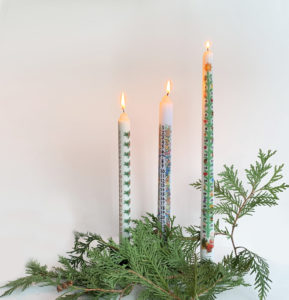
Swedish Angel Chimes are also a popular choice on Scandinavian tables around the world. Four chime candles cause the angels to spin and ring small bells, creating a delicate Christmas sound!
Instead of burning candles, households have been using electric candelabras and hanging electric stars, for years. These are a great way to have light during the dark and cold season, all winter long.
Saint Lucia
Lucia Day is a Swedish holiday celebrated on December 13th. It is a winter celebration of light and marks the beginning of the Christmas season. Saint Lucia, or Saint Lucy, is the bearer of light. The story says, she wore a wreath with candles on her head to light her way on a dark December night, so her hands were free to carry as much food as possible to Christians hiding from persecution in ancient Rome. Modern Lucias wear white robes with a red sash; they walk in processions to deliver food to their families. Ginger cookies and saffron Lucia Buns are served with coffee and sometimes Glogg, a Scandinavian mulled wine with orange and warming spices. Lucia Day is also celebrated in Saint Lucia (in the Caribbean), Finland, Italy, and Norway.
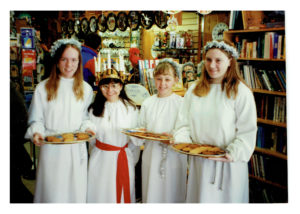
You can read about the full legend of Sankta Lucia here, as well as a recipe for traditional Lucia Buns!
Symbols
There are countless Scandinavian food traditions for Christmas (they could be another article all together!). One of the most iconic is the Julbord, a tradition in Sweden and Norway (Julebord). It means Christmas table and is a buffet of classic holiday foods like meats, fish, pickles, and more! Similar to the Swedish smorgasbord.
In Norway, porridge is a classic Christmas dish. There are several types that Norwegians prepare and it is traditional, on Christmas Eve, to hide a blanched almond (or several) in the pot. Whoever finds it in their bowl wins a prize! That prize is a marzipan pig (julegris). The pig symbolizes Christmas bounty, as pigs often were at the center of Julbord table.

Another animal that is present in Scandinavian Christmas décor and myth is the Julbock or Yule Goat. The straw goats, wrapped with red ribbon, might have derived from Norse mythology and represent good luck and protection.
And of course we can’t forget about the iconic Christmas nisser and tomter, the mischievous. You can read more about their history here! But it wouldn’t be a Scandinavian Christmas without their red hats, white beards, and peeping noses.
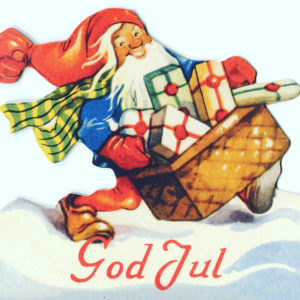
God Jul!
In the Nordic countries, and throughout Europe, Christmas culminates in outdoor Christmas markets where shoppers can participate in activities, shop for gifts and have warming foods and drinks.
Although we’re indoors for most of the holidays in Minnesota, Christmas is the biggest time of the year at Ingebretsen’s and the line out the door of people getting their traditional Christmas foods has garnered a reputation as ‘The Ingebretsen’s Holiday Line.’ We hope to see you this season, and if you are part of our community from afar, we are here to help you incorporate Scandinavian traditions, old and new!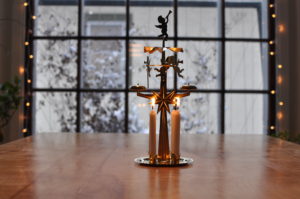
Glædelig Jul – Hyvää Joulua – Gleðileg Jól – God Jul